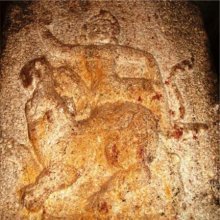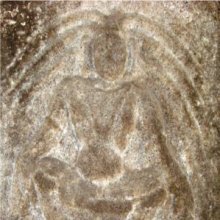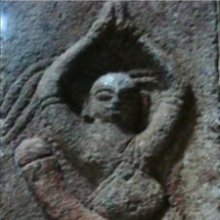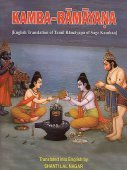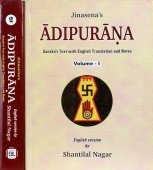Ranganatha, Raṅganātha: 12 definitions
Introduction:
Ranganatha means something in Hinduism, Sanskrit, Marathi. If you want to know the exact meaning, history, etymology or English translation of this term then check out the descriptions on this page. Add your comment or reference to a book if you want to contribute to this summary article.
Images (photo gallery)
In Hinduism
Vaishnavism (Vaishava dharma)
Source: ISKCON Press: GlossaryRaṅganātha (रङ्गनाथ).—Deity of Lord Viṣṇu worshiped in Śrī Raṅgam.
Source: Prabhupada Books: Sri Caitanya CaritamrtaRaṅganātha (रङ्गनाथ).—According to Śrī Caitanya Caritāmṛta, Madya-lila 9.80-81, “After bathing in the river Kāverī, Śrī Caitanya Mahāprabhu saw the temple of Raṅganātha and offered His ardent prayers and obeisances. Thus He felt Himself successful. In the temple of Raṅganātha, Śrī Caitanya Mahāprabhu chanted and danced in ecstatic love of Godhead. Seeing His performance, everyone was struck with wonder.”
When Sudarśanācārya was an old man, the Mohammedans attacked the temple of Raṅganātha and killed about twelve hundred Śrī Vaiṣṇavas. At that time the Deity of Raṅganātha was transferred to the temple of Tirupati in the kingdom of Vijaya-nagara. The governor of Gingeeṅ, Goppaṇārya, brought Śrī Raṅganātha from the temple of Tirupati to a place known as Siṃha-brahma, where the Lord was situated for three years. In the year 1293 Śaka (A.D. 1372) the Deity was reinstalled in the Raṅganātha temple. On the eastern wall of the Raṅganātha temple is an inscription written by Vedānta-deśika relating how Raṅganātha was returned to the temple.
Source: Pure Bhakti: Brhad BhagavatamrtamRaṅganātha (रङ्गनाथ) refers to:—The ancient Deity of Śrī Nārāyaṇa in Śrī Raṅgam, South India. (cf. Glossary page from Śrī Bṛhad-bhāgavatāmṛta).

Vaishnava (वैष्णव, vaiṣṇava) or vaishnavism (vaiṣṇavism) represents a tradition of Hinduism worshipping Vishnu as the supreme Lord. Similar to the Shaktism and Shaivism traditions, Vaishnavism also developed as an individual movement, famous for its exposition of the dashavatara (‘ten avatars of Vishnu’).
Vyakarana (Sanskrit grammar)
Source: Wikisource: A dictionary of Sanskrit grammarRaṅganātha (रङ्गनाथ).—A grammarian,son of नारायणयज्वा (nārāyaṇayajvā), who wrote a commentary named मकरन्द (makaranda) on Haradatta's Padamanjari.

Vyakarana (व्याकरण, vyākaraṇa) refers to Sanskrit grammar and represents one of the six additional sciences (vedanga) to be studied along with the Vedas. Vyakarana concerns itself with the rules of Sanskrit grammar and linguistic analysis in order to establish the correct context of words and sentences.
Shilpashastra (iconography)
Source: Shodhganga: The significance of the mūla-beras (śilpa)Śrī Raṅganātha is the name of a deity depicted at the Ranganathaswamy Temple in Srirangam (Śrī Raṅgam), which represents a sacred place for the worship of Viṣṇu.—[Śrī Raṅganātha as] Viṣṇu sleeps lying on a serpent with five heads, which serve as a canopy. This serpent is called Śeṣa (durable), Ādiśeṣa or Ananta (the eternal). As Viṣṇu sleeps on An anta, he is called Anantaśayana. The two wives of Viṣṇu, Śrīdevī and Bhūmīdevī, sit at his feet. He has often two hands. The right hand is always placed between the head and the pillow. The left hand is placed on the left thigh of the body. The stalk of a lotus issues from the navel of Viṣṇu, and on its flower Brahmā is seated. This posture is the ardhaśayana of Viṣṇu. While depicting in dance, the ardhaśayana posture of Viṣṇu has no separate term. The sleeping posture of Viṣṇu is depicted in dance in pārśvasūcī posture with one leg stretched sideways. The right hand is in patāka and the left hand is in dolā-hasta.

Shilpashastra (शिल्पशास्त्र, śilpaśāstra) represents the ancient Indian science (shastra) of creative arts (shilpa) such as sculpture, iconography and painting. Closely related to Vastushastra (architecture), they often share the same literature.
General definition (in Hinduism)
Source: Shodhganga: The significance of the mūla-berasŚrī Raṅganātha is workshipped as Viṣṇu at the Ranganathaswamy Temple in Srirangam (Śrī Raṅgam) which represents a sacred place for the worship of Viṣṇu.—According to the sthala-purāṇa: [...] After the victorious return of Rāma from Sri Lanka, he gave many valuable presents to every one who served him in the conquest of Lanka. He presented the sacred vimāna of Śrī Raṅganātha to Vibhīṣaṇa for his unselfish and devoted service towards Rāma. Vibhīṣaṇa on his way to Lanka, he placed the Ranga vimāna on the existing abode of Śeṣa-pīṭha (a snake pedestal) on the banks of Śrī Candra Puṣkaraṇi and went on for a wash. At the same time the lord gave his darsan to all the sages and to King Dharma Varma and accepted to stay there to the request of the king. When Vibhīṣaṇa tried to carry the abode of the lord, he was unable to carry. The lord told him that the lord has blessed king Dharma Varma earlier and asked Vibhīṣaṇa to return to his capital of Lanka and that he would see his capital and bless him forever. Thus, Lord Śrī Raṅganātha became the deity for all the kings of the Chola dynasty.
Languages of India and abroad
Marathi-English dictionary
Source: DDSA: The Molesworth Marathi and English Dictionaryraṅganātha (रंगनाथ).—m (S) A common term for the figures (of copper or brass) representative of the child kṛṣṇa in certain postures or attitudes.
Marathi is an Indo-European language having over 70 million native speakers people in (predominantly) Maharashtra India. Marathi, like many other Indo-Aryan languages, evolved from early forms of Prakrit, which itself is a subset of Sanskrit, one of the most ancient languages of the world.
Sanskrit dictionary
Source: Cologne Digital Sanskrit Dictionaries: Cappeller Sanskrit-English DictionaryRaṅganātha (रङ्गनाथ).—[masculine] a man’s name.
Source: Cologne Digital Sanskrit Dictionaries: Aufrecht Catalogus Catalogorum1) Raṅganātha (रङ्गनाथ) as mentioned in Aufrecht’s Catalogus Catalogorum:—son of Devarāja, father of Varadarāja (Mīmāṃsānayavivekadīpikā). Hall. p. 180. Burnell. 84^a.
Raṅganātha has the following synonyms: Raṅgarāja.
2) Raṅganātha (रङ्गनाथ):—son of Sarasvatīvallabha, father of Veṅkaṭeśa (Smṛtiratnākara). L. 2561.
3) Raṅganātha (रङ्गनाथ):—son of Śaṅkara, eldest brother of Nīlakaṇṭha (Bhagavantabhāskara). Quoted in Prāyaścittamayūkha.
4) Raṅganātha (रङ्गनाथ):—Advaitacintāmaṇi. K. 114.
5) Raṅganātha (रङ्गनाथ):—Āyurjñāna jy.
6) Raṅganātha (रङ्गनाथ):—Karpūrastavadīpikā.
7) Raṅganātha (रङ्गनाथ):—Guṇamandāramañjarī
8) Raṅganātha (रङ्गनाथ):—Jīvanmuktiviveka.
9) Raṅganātha (रङ्गनाथ):—a pupil of Ānandāśrama: Brahmasūtravṛtti Vidvajjanamanoramā.
10) Raṅganātha (रङ्गनाथ):—Rāmānujasiddhāntapadavī.
11) Raṅganātha (रङ्गनाथ):—Vṛttaratnākaraṭīkā.
12) Raṅganātha (रङ्गनाथ):—son of Nṛsiṃha: Mitabhāṣiṇī Līlāvatīṭīkā. Palabhākhaṇḍana. Bhaṅgīvibhaṅgīkaraṇa. Lohagolakhaṇḍana.
13) Raṅganātha (रङ्गनाथ):—son of Ballāla Gaṇaka, brother of Rāma, Kṛṣṇa, Govinda, Mahādeva, and father of Viśvarūpa (Munīśvara): Sūryasiddhāntagūḍhārthaprakāśaka, composed in 1604. The following works are attributed to a Raṅganātha, but, for the present, it must suffice to enumerate them without further guarantee. Nārāyaṇīya Bīja. Ben. 28. ‘By Nārāyaṇa’ Sb. 257.
—[commentary] on Divākara’s Jātakapaddhati. Ben. 26. Nisṛṣṭārthadūtī Līlāvatīṭīkā. Ben. 28. But Sb. 256 attributes it to Viśvarūpa. Prauḍhamanoramā on Keśvārka’s Jātakapaddhati. Ben. 26. Np. Ii, 114. Munīśvarīyapāṭīsāra. Ben. 28. Rather by Munīśvara himself. Siddhāntacūḍāmaṇi. Np. X, 48.
14) Raṅganātha (रङ्गनाथ):—son of Bālakṛṣṇa, son of Raṅganātha, son of Nānabhaṭṭa, nephew of Nārāyaṇa, brother of Veṇīmādhava: Vikramorvaśīprakāśikā, written in 1656. Oxf. 135^b.
15) Raṅganātha (रङ्गनाथ):—son of Nṛsiṃha, the author of the Mitabhāṣiṇī Līlāvatīṭīkā, was the brother of the astronomer Kamalākara, Catal. Io. p. 1007.
16) Raṅganātha (रङ्गनाथ):—another name of Parāśara Bhaṭṭa (Bhagavadguṇadarpaṇa).
17) Raṅganātha (रङ्गनाथ):—and raṅgarāja in works. See also Śrīraṅga.
18) Raṅganātha (रङ्गनाथ):—Kṛṣṇamānasapūjā.
19) Raṅganātha (रङ्गनाथ):—Pitṛmedhavivaraṇa.
20) Raṅganātha (रङ्गनाथ):—Vāsavadattāṭīkā.
21) Raṅganātha (रङ्गनाथ):—son of Śrīnivāsa: Vivādārthasaṃgrahaṇa vedānta.
Source: Cologne Digital Sanskrit Dictionaries: Monier-Williams Sanskrit-English Dictionary1) Raṅganātha (रङ्गनाथ):—[=raṅga-nātha] [from raṅga > raj] m. (also with bhaṭṭa, dīkṣita, ācārya, yajvan, sūri) Name of various authors and other men, ([especially]) of a [Scholiast or Commentator] on the Vikramôrvaśī (A. D. 1656) and a [Scholiast or Commentator] on the Sūrya-siddhānta
2) [v.s. ...] of a place, [Catalogue(s)]
[Sanskrit to German]
Sanskrit, also spelled संस्कृतम् (saṃskṛtam), is an ancient language of India commonly seen as the grandmother of the Indo-European language family (even English!). Closely allied with Prakrit and Pali, Sanskrit is more exhaustive in both grammar and terms and has the most extensive collection of literature in the world, greatly surpassing its sister-languages Greek and Latin.
See also (Relevant definitions)
Partial matches: Natha, Ranga.
Starts with (+1): Ranganatha acarya, Ranganatha arada, Ranganatha bhatta, Ranganatha dikshita, Ranganatha suri, Ranganatha yajvan, Ranganathadeshikahnika, Ranganathamahatmya, Ranganathamangalastotra, Ranganathanamaratna, Ranganathanataka, Ranganathanushasana, Ranganathapadukasahasra, Ranganathapadukasahasrastotra, Ranganathaprahasana, Ranganathar, Ranganathashtaka, Ranganathashtottarashata, Ranganathastotra, Ranganathaswamy.
Ends with: Shriranganatha, Uddandaranganatha.
Full-text (+139): Ranghanatha, Munishvara, Shriranganatha, Ranganathadeshikahnika, Ranganathastotra, Ranganathamahatmya, Ranganathanataka, Ranganathanamaratna, Ranganathapadukasahasra, Ranganathamangalastotra, Rankanatan, Ranganathashtaka, Ranganathiya, Ranganathanushasana, Ranganathashtottarashata, Pashcimaranganathastotra, Uddandaranganatha, Shriranganathasuprabhata, Shriranganathamangalashasana, Shriranganathastotra.
Relevant text
Search found 24 books and stories containing Ranganatha, Ranga-natha, Raṅga-nātha, Raṅganātha; (plurals include: Ranganathas, nathas, nāthas, Raṅganāthas). You can also click to the full overview containing English textual excerpts. Below are direct links for the most relevant articles:
Garga Samhita (English) (by Danavir Goswami)
Verse 3.7.33 < [Chapter 7 - The Holy Places of Śrī Girirāja]
Verse 8.13.106 < [Chapter 13 - A Thousand Names of Lord Balarāma]
Brihad Bhagavatamrita (commentary) (by Śrī Śrīmad Bhaktivedānta Nārāyana Gosvāmī Mahārāja)
Verse 2.4.205 < [Chapter 4 - Vaikuṇṭha (the spiritual world)]
Verse 2.4.155-157 < [Chapter 4 - Vaikuṇṭha (the spiritual world)]
Tondaradippodi: Poet and Saint < [July – September, 1983]
Dr. C. R. Reddy: Epoch Maker in Telugu Criticism < [October – December, 1980]
The Romance of Andal < [June 1946]
Tiruvaymoli (Thiruvaimozhi): English translation (by S. Satyamurthi Ayyangar)
Pasuram 7.2.11 < [Section 2 - Second Tiruvaymoli (Kankulum Pakalum)]
Pasuram 6.10.11 < [Section 10 - Tenth Tiruvaymoli (Ulakam unta Peruvaya)]
Pasuram 4.3.5 < [Section 3 - Third Tiruvaymoli (Kovai Vayal)]
A History of Indian Philosophy Volume 3 (by Surendranath Dasgupta)
Part 1 - The Aḻagiyas from Nāthamuni to Rāmānuja < [Chapter XVIII - An Historical and Literary Survey of the Viśiṣṭādvaita School of Thought]
Part 4 - Rāmānuja Literature < [Chapter XVIII - An Historical and Literary Survey of the Viśiṣṭādvaita School of Thought]
Part 5 - The Influence of the Āḻvārs on the followers of Rāmānuja < [Chapter XVIII - An Historical and Literary Survey of the Viśiṣṭādvaita School of Thought]
The history of Andhra country (1000 AD - 1500 AD) (by Yashoda Devi)
Part 18 - The Gona (Kona) Haihayas of Vardhamanapura (A.D. 1190-1294) < [Chapter II - The Haihayas]
Part 35 - Rajagandagopala alias Ranganatha (A D. 1299-1325) < [Chapter XX - The Telugu Cholas (Chodas)]
Part 34 - Mamnagandagopala (A.D. 1231-1299) < [Chapter XX - The Telugu Cholas (Chodas)]
Related products
